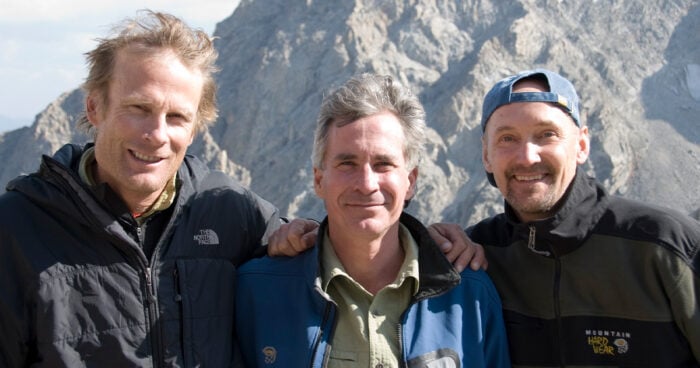
The late David Breashears (middle) with Conrad Anker (left) and John Ackerly (right). An elite mountaineer and accomplished filmmaker, Breashears used his unique talents to shine a spotlight on Tibet.
The International Campaign for Tibet is mourning the loss of David Breashears, a history-making mountaineer and Emmy-winning filmmaker who used his special talents to shine a spotlight on Tibet.
Breashears died of natural causes on March 14 at age 68 at his home in Marblehead, Massachusetts.
ICT Board Member and former President John Ackerly had been a good friend of Breashears since their first trip to Tibet together in 1992, when he guided Breashears to get footage of Tibetan prisons. “The determination that made David famous as a mountaineer enabled him to get closer to prisons than any other photographer—and to run even faster when we were about to get caught,” Ackerly said.
Breashears became famous as a rock climber and mountaineer before pivoting to become a filmmaker and an activist for the climate and the peoples of Nepal and Tibet. He founded GlacierWorks in 2007 to show how fast glaciers were receding as humans warm the Earth.
Breashears was a founding member of the Board of Advisors of the Rowell Fund for Tibet, which provides grants to Tibetans making contributions in the fields of visual arts and media, as well as environmental and women’s rights. The fund continues the legacy of Breashears’ friends Barbara and Galen Rowell, who created the book “My Tibet” with His Holiness the Dalai Lama and died in a tragic plane crash in 2002.
As a filmmaker, Breashears worked on several projects related to Tibet, including the 1997 feature film “Seven Years in Tibet” starring Brad Pitt. According to The New York Times, during the film’s production, Breashears “smuggled a camera into Lhasa, the Tibetan capital, running the risk of arrest by the Chinese authorities.” China has illegally occupied Tibet for over 65 years.
Breashears was also the driving force behind “Red Flag Over Tibet,” a 1994 Frontline, WGBH-TV program shot in Tibet, as well as in India and Nepal.
An elite mountaineer, Breashears in 1983 transmitted the first live television pictures from the summit of Mount Everest, which Tibetans know as Chomolangma. Two years later, Breashears became the first American to reach the summit twice.
In 1996, Breashears co-directed and photographed the first IMAX film shot on Mount Everest. When an infamous blizzard hit the mountain that May, Breashears and his team stopped filming to help stranded climbers, earning praise for their courage.
When Breashears’ expedition eventually reached the summit, a member of the team, Jamling Tenzing Norgay, son of the legendary Sherpa mountaineer Tenzing Norgay, placed photos of the Dalai Lama and Buddhist prayer flags there.
“Everest,” the film that Breashears co-directed about the expedition, is the highest-grossing IMAX documentary of all time.
Breashears talked about the making of “Everest” during fundraisers he hosted for the International Campaign for Tibet.
Breashears was also a good friend and mentor to many ICT members, including Bob Palais and Blake Kerr.
“David was a purist and a perfectionist,” said Palais, a research professor in mathematics at the University of Utah. “It would seem nearly impossible to sustain those ideals in any one of the realms in which he exceeded: bold climbs from groundfall to high altitude, extreme cinematography, human rights advocacy and climate science, culinary arts and the art of friendship … but he made them all look effortless.”
Breashears also used his skills to raise money for the Rowell Fund for Tibet.
Along with John Ackerly, Jimmy Chin and ICT President Tencho Gyatso, Breashears helped guide ICT members to the summit of Grand Teton in Wyoming, raising $60,000 for the fund.
“A mountain is a challenge and requires determination and fortitude, and the situation in Tibet is a metaphor for that,” Breashears told media covering the climb.
He added: “It’s a long struggle, but we have to be active … The climb wasn’t the end of an effort, it’s the beginning of the effort.”

